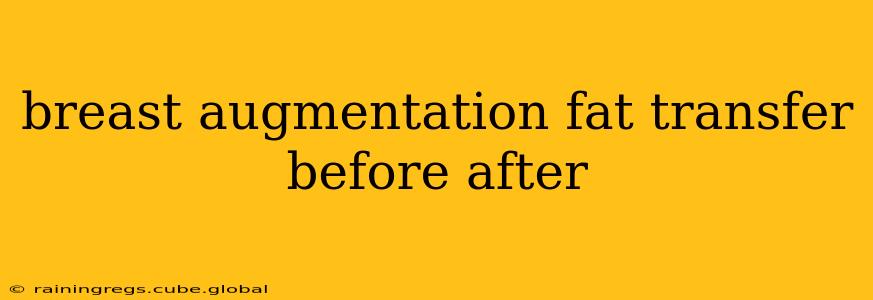Breast augmentation using fat transfer, also known as autologous fat grafting or lipofilling, is a procedure where fat is harvested from one area of the body and injected into the breasts to increase their size and fullness. Unlike traditional breast augmentation with implants, this technique uses the patient's own tissue, offering a natural look and feel. However, it's crucial to understand the process, potential outcomes, and limitations before making a decision. This comprehensive guide explores breast augmentation with fat transfer, covering before and after aspects, frequently asked questions, and vital considerations.
What Does Breast Augmentation with Fat Transfer Involve?
The procedure generally involves three main steps:
-
Liposuction: Fat is carefully extracted from areas with excess fat, such as the abdomen, thighs, or hips, using liposuction techniques. The extracted fat is then processed to remove impurities and prepare it for transfer.
-
Fat Processing: The harvested fat undergoes a purification process to separate the fat cells from other components like blood and fluid. This helps ensure the viability of the transplanted fat cells.
-
Fat Injection: The purified fat is meticulously injected into the breast tissue using small cannulas. The surgeon strategically places the fat to achieve the desired shape and volume.
What are the Benefits of Breast Augmentation with Fat Transfer?
-
Natural Look and Feel: Since it uses your own fat, the results look and feel more natural compared to implants. The breasts integrate seamlessly with the surrounding tissue.
-
Improved Breast Shape and Symmetry: Fat grafting can correct asymmetries and enhance the overall shape of the breasts.
-
Reduced Scarring: The incisions for liposuction are typically small and well-concealed.
-
No Foreign Body: There's no risk of implant rupture or other complications associated with silicone or saline implants.
-
Potential for Breast Reconstruction: Fat transfer is sometimes used in breast reconstruction after mastectomy.
What are the Drawbacks of Breast Augmentation with Fat Transfer?
-
Limited Volume Increase: Fat transfer typically results in a more modest increase in breast size compared to implants. Multiple procedures might be needed for significant augmentation.
-
Fat Absorption: A portion of the transferred fat is naturally absorbed by the body. The surgeon will generally over-correct to account for this absorption.
-
Uneven Results: The distribution of fat may not be perfectly uniform, potentially leading to slight asymmetries.
-
Longer Recovery Time: The recovery period is generally longer than with implant augmentation.
-
Higher Cost per mL of augmentation: This can be significantly more expensive than implant surgery for the same volume increase.
How Long Does the Recovery Take?
Recovery time varies depending on the individual and the extent of the procedure. Expect some bruising, swelling, and discomfort for several weeks. A compression garment is usually worn to minimize swelling. Full recovery may take several months, and you may need multiple follow-up appointments.
How Much Does Breast Augmentation with Fat Transfer Cost?
The cost varies based on several factors, including the surgeon's fees, the amount of fat transferred, the geographic location, and the anesthesia required. It's always best to consult with multiple surgeons for detailed cost estimates.
What is the Success Rate of Breast Augmentation with Fat Transfer?
The success rate depends on various factors, including the skill of the surgeon, the patient's overall health, and the body's response to the procedure. While a significant portion of the transferred fat typically survives, some absorption is expected. The surgeon will discuss realistic expectations during the consultation.
What are the Risks and Complications?
Potential risks and complications include:
-
Infection: As with any surgical procedure, infection is a possibility.
-
Seroma: Fluid accumulation under the skin.
-
Fat Necrosis: Death of fat cells, which can lead to lumps or irregularities.
-
Numbness: Temporary or permanent numbness in the breast area.
-
Asymmetry: Uneven results.
-
Poor graft take: Less fat surviving than expected.
How Can I Find a Qualified Surgeon?
It's essential to choose a board-certified plastic surgeon experienced in fat transfer breast augmentation. Look for surgeons with extensive training and a strong track record of successful procedures. Consult multiple surgeons to find the right fit for your needs and preferences. Ask to see before-and-after photos and discuss your individual goals and expectations in detail.
Remember, this information is for general educational purposes only and should not be considered medical advice. Always consult with a qualified medical professional to determine the best course of action for your individual circumstances.
